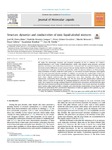Structure, Dynamics and Conductivities of Ionic Liquid-Alcohol Mixtures

Ver/
Use este enlace para citar
http://hdl.handle.net/2183/30850
A non ser que se indique outra cousa, a licenza do ítem descríbese como Atribución-NoComercial-SinDerivadas 4.0 Internacional
Coleccións
- Investigación (FCIE) [1221]
Metadatos
Mostrar o rexistro completo do ítemTítulo
Structure, Dynamics and Conductivities of Ionic Liquid-Alcohol MixturesAutor(es)
Data
2022-03-19Cita bibliográfica
Otero-Mato, J.M., Montes-Campos, H., Gómez-González, V., Montoto, M., Cabeza, O., Kondrat, S., Varela, L.M., 2022. Structure, dynamics and conductivities of ionic liquid-alcohol mixtures. Journal of Molecular Liquids 355, 118955. https://doi.org/10.1016/j.molliq.2022.118955
Resumo
[Abstract] We study the microscopic structure and transport properties of ions in mixtures of 1-butyl-3-methylimidazolium and 1-butyl-3-ethylimidazolium iodide with ethanol using atomistic molecular dynamics simulations and conductivity measurements. Compared with the same ionic liquids in water, we reveal essential differences in ionic structure that are closely related to the differences in the solubility mechanisms of both types of solvents. In particular, unlike for aqueous solutions, we find a homogeneous distribution of solvent molecules in the system, i.e., we observe no cluster formation, which agrees with the nano-structured solvation paradigm. In addition, we calculate the conductivities of these systems in the whole concentration range and compare them with experimental data. Although the simulated values slightly underestimate the experimental ones, they reproduce the shape of the experimental conductivity dome reasonably well. We also show that the pseudo-lattice random-alloy model, which is based on microscopic ion jumping frequencies, describes the conductivity data accurately. We compute the average jumping frequencies directly from simulations and find that they agree well with those obtained by fitting the simulation conductivity data. These results show that the pseudo-lattice random-alloy model provides a valuable tool to describe the conductivities of ionic liquid–solvent mixtures and particularly their concentration dependence. It shall also apply to other systems, e.g., inorganic electrolytes and dispersed ionic conductors.
Palabras chave
Ionic liquids
Conductivity
Structure
Alcohols
Molecular dynamics simulations
Conductivity
Structure
Alcohols
Molecular dynamics simulations
Versión do editor
Dereitos
Atribución-NoComercial-SinDerivadas 4.0 Internacional
ISSN
0167-7322






